1970 Spanish Grand Prix race report: Stewart the matador
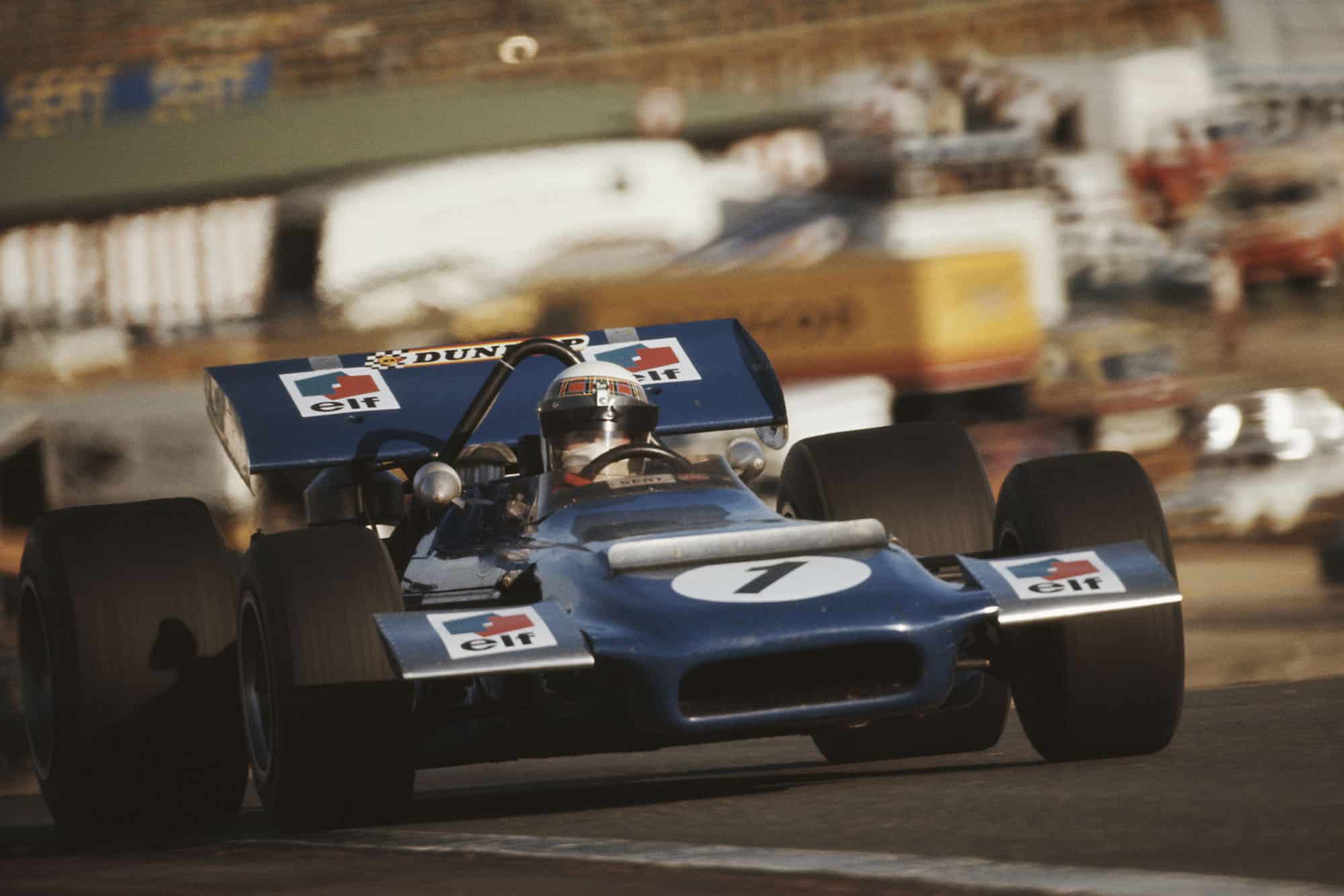
Jackie Stewart won his first race of the season for Tyrrell
Motorsport Images
After more than a reasonable amount of confusion, caused in part by misinterpretation of decisions, lack of unanimous agreement among team managers, a willingness by the organisers to change decisions that created even more confusion and an untimely intervention by the FIA representatives, the twenty-two drivers who turned up for practice got through two days of practice and sixteen of them eventually lined up for the start.
First practice was on Friday, more or less from 10:30am to 2pm, and when it started the pits seemed to be knee-deep in March cars, the way it used to be with 250F Maseratis in the mid-1950s. The Tyrrell team had three blue ones, the STP-March works team had a red one and two Dayglow red ones, and the STP Corporation had their car now painted in Dayglow red colours.
Stewart was driving 701/2, with 701/4 as a spare, Servoz-Gavin had the new 701/6 and in the works team Amon had 701/1, with the new lightweight 701/7 as spare, and Siffert had 705/5, while Andretti had 701/3.
There were five Lotus cars, the brand new 72/2 for Rindt, the prototype 72/1 for Miles, the old 49C/R10 on loan to Soler-Roig, the other works 49C/R6 as a spare, and Hill in Walker’s 49C/127.
McLaren Racing fielded three cars, M14A/2 for Hulme, the completely rebuilt M14A/1 for McLaren and the new Alfa Romeo-engined M7D/1 for de Adamich. BRM also had a three-car team, with 153/01 for Oliver, 153/02 for Rodriguez and 153/03 for Eaton, while the rest were two-car or single-car teams, comprised of Matra with Beltoise in MS120/01, and Pescarolo in MS120/02, Brabham with himself in BT33/2 and Stommelen in BT33/1, Ferrari with 001 and 002 for Ickx, De Tomaso-Williams with 505/38/1 for Courage, and Surtees with his McLaren M7C/1.
Qualifying
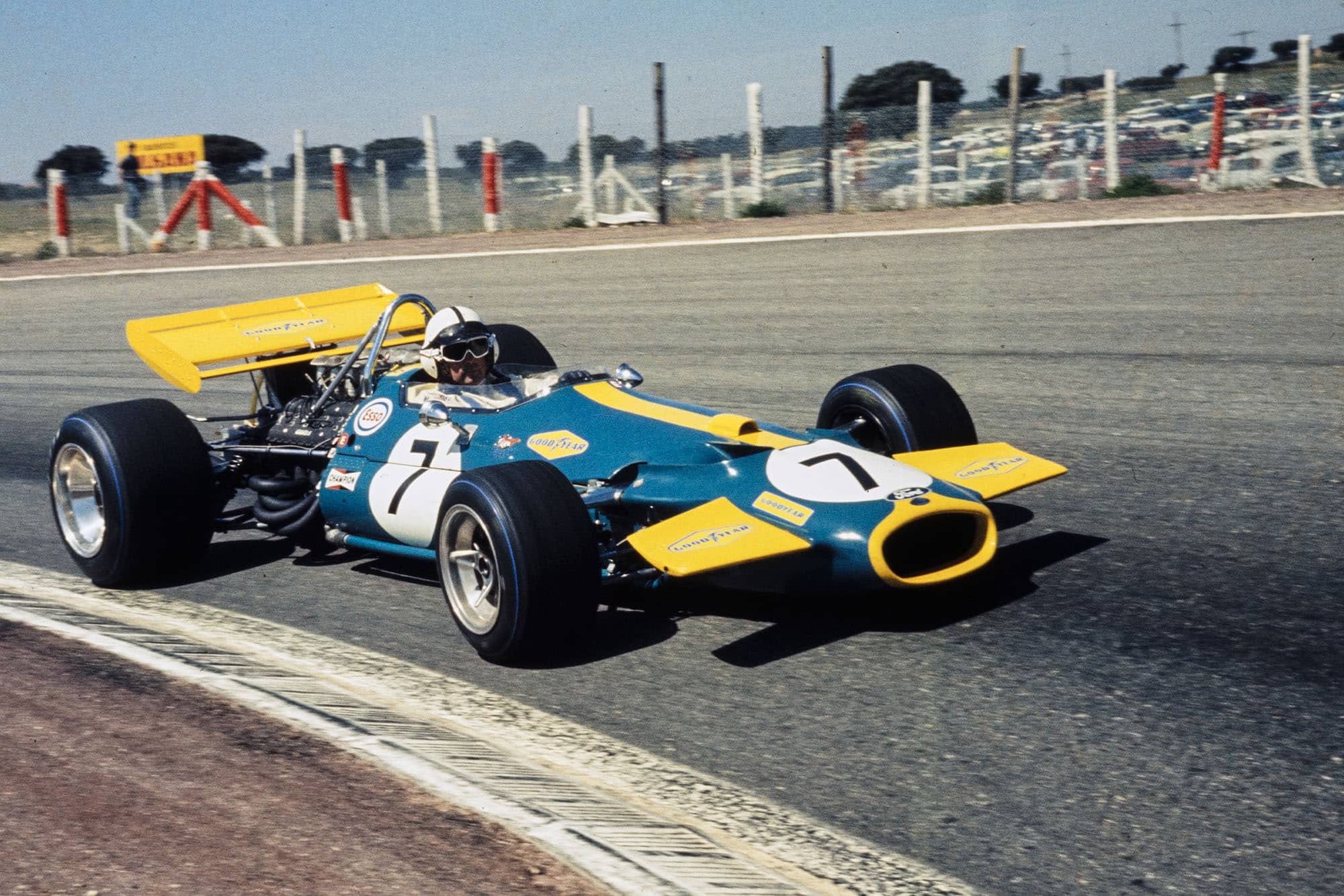
Jack Brabham took his first pole of the season
Motorsport Images
The first day of practice was divided into four sessions, the third one being reserved for the number two drivers of each team, who had to qualify for the starting grid, the number one drivers and World Champions being automatically elected for starting. This qualifying group comprised McLaren, Courage, Siffert, Oliver, Servoz-Gavin, Andretti, Miles, de Adamich, Eaton, Pescarolo, Soler-Roig and Stommelen, and it was at this point that confusion really got under way, for while the times recorded in this half-hour were going to select the fastest six for places on the grid, they were not going to count for positions on the grid.
Due to a misunderstanding practice should have finished at this point but the shop steward of the team managers stamped his foot and demanded another half-hour of practice for everyone, the times to count for the grid, but everyone did not know this, so quite a number of drivers who had already made good lap times did not go out again, thinking it was an untimed session.
“The Matras were on great form and bringing a joyous new song to Grand Prix racing”
Apart from these organisational troubles there were also mechanical troubles, for the first Ferrari made an awful ticking noise in the engine, which was the latest version of the flat-12 with lots of new parts in it, and the March mechanics were busy completing their latest kit of parts. Stewart was having to work awfully hard to keep his March going in the direction he wanted, and the Lotus 72s were suffering from too much roll on corners and their Cosworth engines were giving bother with electrics.
The Matras were on great form and bringing a joyous new song to Grand Prix racing, and both drivers were taking joy from harrowing Stewart in his March if he was not trying really hard. The Alfa Romeo-engined McLaren was surprising a lot of people and going well.
As it is two years since Formula One cars have been at Jarama in any serious form, last year’s GP being at Barcelona, the lap times were all well under the old record and by the end of the day even the slowest driver was well under the official 1min 27.9sec that was the fastest practice lap in 1967, set up by Amon (Ferrari). Fastest of all was Hulme with 1 min. 24.1 sec. and he had been quietly getting on with the job, and not even looking particularly fast, a sure sign of a professional driver.
Overnight an announcement came out from the FIA representatives present that there would be a change in the practice times rule and that only those recorded during the two half-hour periods of Friday would count for the grid. This really put the fertiliser into the ventilator, and provoked immediate protests from McLaren’s team and Surtees, for neither had taken part in the final Friday session, thinking it was untimed and that their earlier times were good enough. While practice went on from about 4pm to 6:30pm on Saturday there were union officials, team-managers, organisers and FIA officials running in all directions, and so many decisions being made that the whole thing was indecisive.
Meanwhile drivers were driving hard, cars were breaking and accidents were happening. The first Ferrari had been fitted with a new engine but it was having electrical troubles, the second one was having fuel-feed troubles, BRM were in dire trouble with front stub axles breaking, Oliver having to abandon his car just before the pits, Courage lost control of the De Tomaso and hit a guard-rail really hard, which did the car a lot of damage, and Hill spun off into a wire-netting catch-fence and bent the rear of Walker’s Lotus.
The Lotus 72s just would not run properly, and the BRM engines were misfiring and giving the Lucas people some electrical headaches. Eaton’s BRM was robbed of front stub axle parts to keep Oliver on the go, and Rodriguez was well in the running, using some new super low-profile Dunlops.
For all the impression that Andretti was making with the STP Oil Treatment Special he might not have been there, and Stewart was really perspiring in his effort to keep near the front. Amongst it all wily old Brabham was quietly pressing on and when all the confusion died down he had clocked 1min 23.9sec – a clear leader of the day. Before everything ended there were 30 minutes for the “also-rans” to have another go at qualifying for the grid, which was when Courage crashed, and this caused the session to be stopped short, so after a pause there was a final 10 minutes for them, in which Andretti, Oliver, Stommelen, Pescarolo, Soler-Roig, Miles, de Adamich, Servoz-Gavin and McLaren took part.
By this time confusion over what was going to count and what wasn’t had reached its height, and Ferrari was protesting about the Constructors’ Association (he is not a member) changing the rules, everyone was complaining about the FIA decision on qualifying, and tempers were getting very short. The result was that the last 10-minute thrash saw some really inspired driving, which was exciting to watch, for everyone let their hair down and became real racing drivers for a brief moment, instead of trying to be “Pop-Stars”. As darkness fell confusion was in full swing and it only needed a full orchestral backing for the whole production to have scored a hit at Covent Garden Opera House.
Race
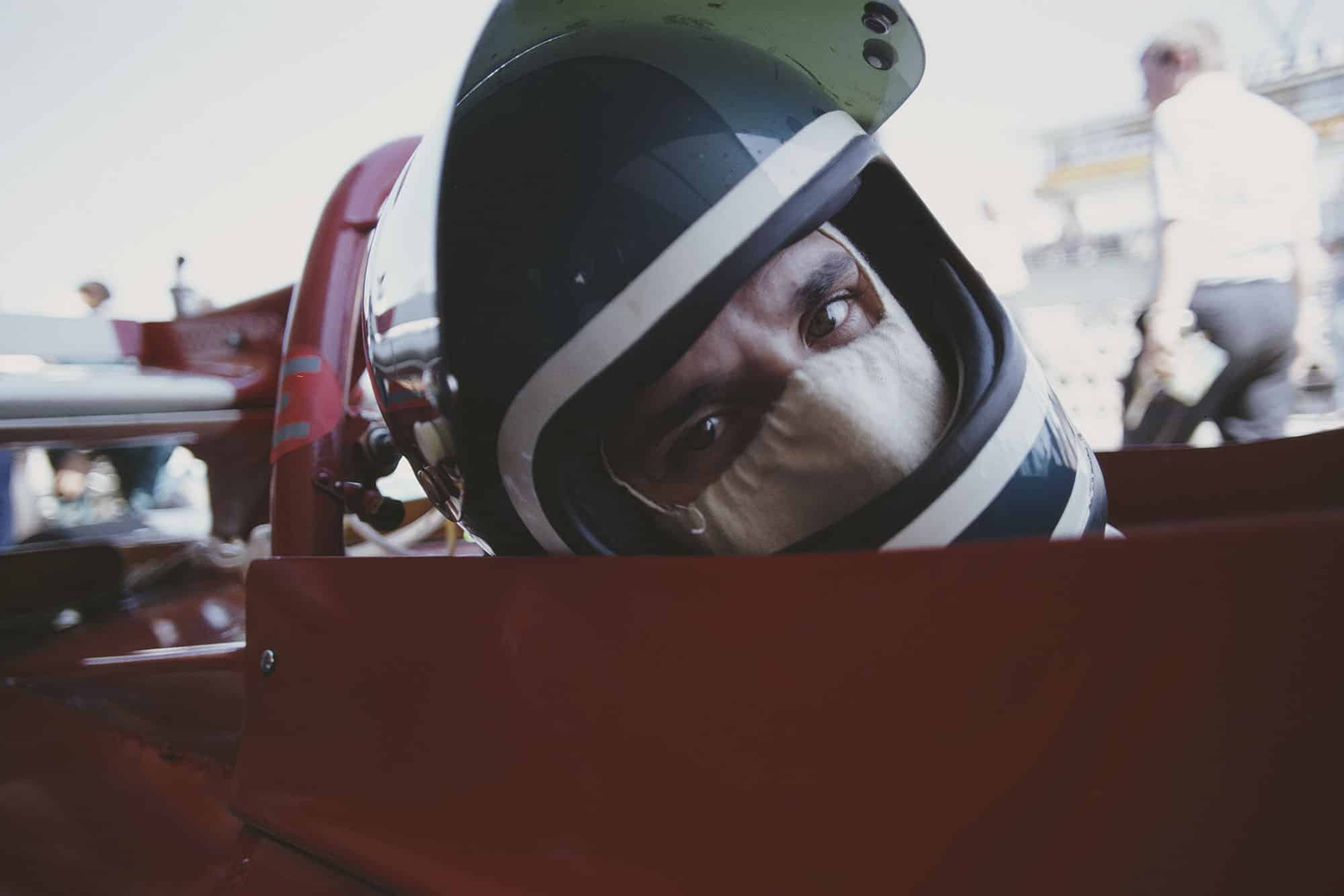
Jacky Ickx prepares for the start
Motorsport Images
On Sunday morning the Spanish skies were clear and blue and the FIA officials had made their decisions, over-ruling any Club rules or Association rules, or protest sheets or unanimous proposals from drivers or entrants. The sixteen starters for the 90-lap Spanish Grand Prix would consist of the ten seeded drivers and the six fastest qualifiers, which were Pescarolo, Oliver, McLaren, Courage, Servoz-Gavin and Andretti. If the De Tomaso was not repaired and Courage could not start then Stommelen would be the next one in.
In spite of this declaration there was still a song and dance in the paddock and a petition was got up to let everyone start, with some side issues about whether they would be classified or get prize money. The race was due to start at 4pm, thankfully without any supporting races beforehand to add to the confusion. While one club official agreed to the petition no-one consulted the FIA Stewards and twenty-one cars assembled on the grid. At the last moment the Stewards saw what was happening and ruled the last four cars out-of-court and they were pushed back in the paddock.
“Oliver’s BRM was in trouble and rammed the Ferrari of Ickx amidships on the apex of the hairpin”
The sixteen cars did a warm-up lap, formed up on the “dummy-grid”, moved forward to the starting grid, and got away splendidly when the flag fell. Stewart made a superb start and led Hulme and Brabham into the first corner, with the pack following. Round the slow twists and turns it was follow-my-leader, and as they came to the downhill hairpin after the esses, Oliver’s BRM was in trouble and rammed the Ferrari of Ickx amidships on the apex of the hairpin.
The Ferrari side tank was split right open and both cars went off the road and caught fire. Oliver escaped unhurt and Ickx was taken out of the damaged Ferrari by the fire-marshals, but not before he suffered some nasty burns on arms and legs, and one of the firemen was also slightly burnt. While the race went on the two cars burnt furiously, having full petrol tanks, and both were completely gutted. With water, foam and marshals all ewer the road the pace was naturally slowed down, but Stewart was well out in front.
The BRM pit flagged Rodriguez in and withdrew his car, fearing the accident had been caused by a recurrence of the front stub axle trouble they had experienced in practice. At the back of the field Amon was in trouble with a very flat-sounding engine and was soon in the pits. When Rodriguez was withdrawn he was in fourth place, and his going left a gap until Pescarolo and Beltoise arrived in the crisp-sounding Matras.
Hulme and Brabham were not losing contact with Stewart, but were not closing on him and it looked as though the Scotsman’s superior driving ability was overcoming anything the March car or Dunlop tyres lacked. Almost before things were settled down Hulme came to a stop just as he was starting the back part of the circuit on lap 10. The rotor arm in the ignition distributor had broken and though a mechanic took another one out to him, and he got restarted, he only managed to complete that lap before the same thing happened, so obviously there was something very much amiss in the distributor and that was the end of his race.
As this was happening Pescarolo’s Matra lost the sharp edge off its sound and he dropped back, but Beltoise began to close on Brabham. The tail-enders were scrapping away merrily, Surtees pursuing McLaren, and Andretti having Hill and Stommelen pressing him hard, while Servoz-Gavin brought up the rear, so Tyrrell March cars were first and last. Rindt had dropped out with ignition trouble before he could show the paces of the new Lotus 72, and with the race barely started it was virtually all over.
Stewart was driving hard, not accepting any demoralising like he did in South Africa, and he was getting more out of a March than anyone else would ever be likely to achieve, his car running with the pannier tanks in view of the race distance. Beltoise was on great form and the Matra sounded terrific, and after pursuing Brabham he finally got by into second place on lap 16, and proceeded to maintain the gap between himself and Stewart, even though Stewart was trying really hard.
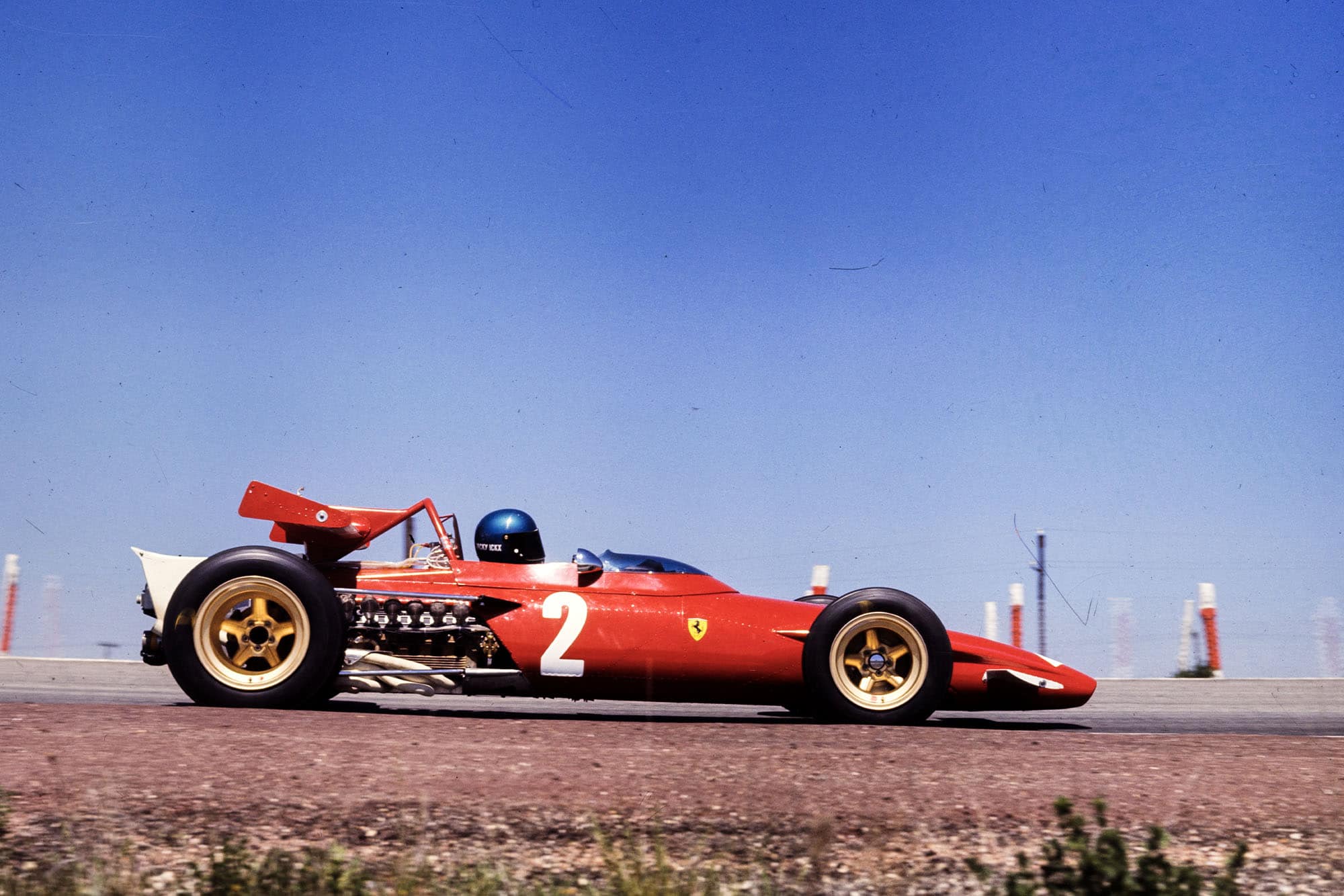
Ickx was subsequently eliminated in an opening lap incident
Motorsport Images
At twenty laps the order was Stewart (March), Beltoise (Matra); Brabham (Brabham), Beltoise (Matra), Surtees (McLaren), McLaren (McLaren), Andretti (March), Stommelen (Brabham) and Servoz-Gavin (March), the Frenchman having already been lapped by the leader.
Apart from the little group at the tail of the field stalemate had set in, and the cars were all taking on a grey colour from the fire-fighting foam that was running across the track, for the Ferrari had rolled down to the inside of the hairpin and both cars were still burning.
On lap 29 Beltoise lost a lot of ground to Stewart; having maintained a steady 61sec gap, and as the Matra completed lap 31 the engine seized and Beltoise coasted to a stop as Brabham went by into second place. Only three laps later Pescarolo skated to a stop at the top of the Pegaso Ramp as a con-rod broke and locked up the engine, so that was the end of the Matras, but they had shown good promise.
The race was nowhere near half-distance-and already there were only nine cars running and then Stommelen’s engine went flat, and though he struggled on with a few pit stops he was doomed to retire.
As a race it was not the most exciting, but one had to admire Stewart’s driving and Brabham’s perseverance for he was only 5sec behind at half-distance. Surtees was just on the same lap, and the remainder had been lapped. After being lapped by Stewart the gearbox on Suttees’ McLaren started to give trouble and he dropped back, being passed by McLaren, then Hill and then Andretti, and a few laps later Hill also had trouble finding gears in his Hewland box and was passed by Andretti, the American not shining as expected but just keeping going steadily.
“It looked inevitable for Brabham to take the lead, but how and where was another matter for Stewart was not giving in this time”
Meanwhile Brabham was closing up on Stewart and gat right on his tail as the race approached two-thirds distance, but out of two of the hairpins Stewart pulled away as Brabham was broadsiding-on opposite-lock. This was just enough for Stewart to maintain his lead and at the height of this brief battle he recorded his fastest lap, on lap 60, Brabham having made his fastest on lap 19.
Although Stewart was fighting hard it looked inevitable for Brabham to take the lead, but how and where was another matter for Stewart was not giving in this time. The battle resolved itself when Brabham’s Cosworth engine went bang and that was that. He coasted into the pits and his mechanics did not even bother to look at it.
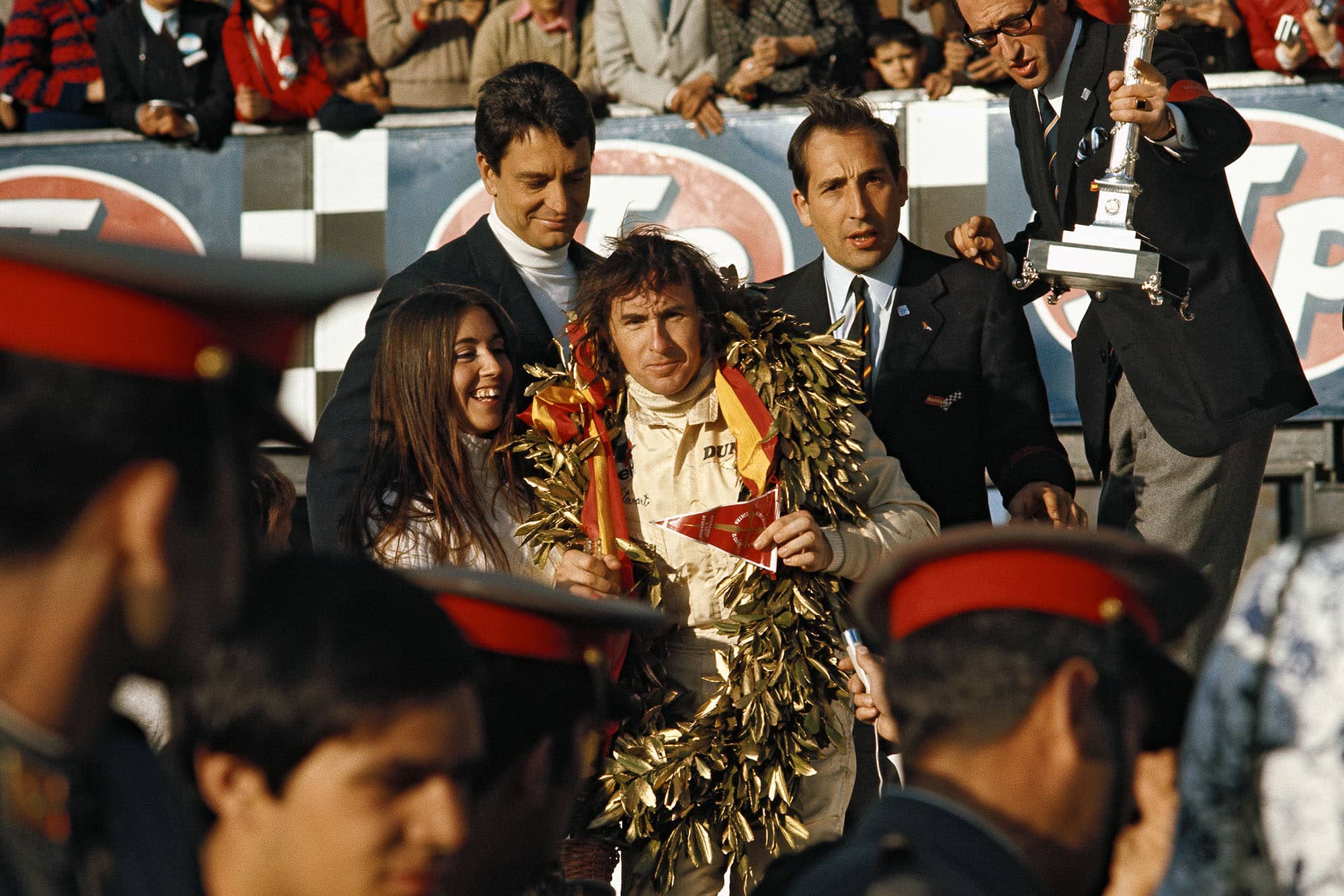
Stewart soaks up the adulation on the podium
Motorsport Images
It was now all over, McLaren was in second place, Andretti third, Hill fourth, Suttees fifth (but not for much longer) and Servoz-Gavin sixth. Stewart had a full lap lead on the second man and he reeled off the remaining laps at his leisure, bringing the Tyrrell March home to its first World Championship Grand Prix victory in only its third race. while two victories and a third place speak wonders for the Tyrrell team organisation and preparation by the mechanics, compared with other teams; and on top of victory their second car finished as well, albeit in last place.
Never has a Grand Prix been so fraught with wrangles and complaints, a disease that used to affect sports-car racing, when Grand Prix racing was good clean sport. Since the introduction of big-business interests and the formation of this Association and that Association, with busy little “shop stewards”, Grand Prix racing has gone to the dogs. Let us hope it does not sink any lower, or Formula Ford will be the blue-eyed sport.
